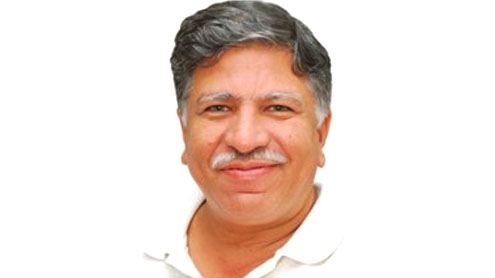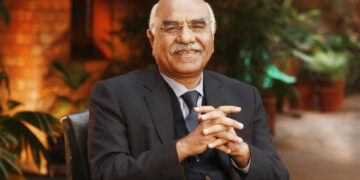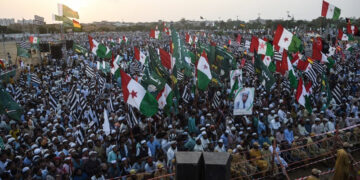 This last one was a kind of happening week. Gen Dempsey holding forth in a vein not too dissimilar from before and the envoys conference in Islamabad revisiting our foreign policy; hearing of the various cases in the apex court, including the revived NRO case; passing of the landmark Anti-Women Practices Bill and almost simultaneously being reminded why the law was so desperately needed yet could have so little impact without the society changing its mindset and values, through the sentencing of a family of four Belgian-Pakistanis from sizable to long prison sentences for having killed their own slip of a girl for ‘honour’.
This last one was a kind of happening week. Gen Dempsey holding forth in a vein not too dissimilar from before and the envoys conference in Islamabad revisiting our foreign policy; hearing of the various cases in the apex court, including the revived NRO case; passing of the landmark Anti-Women Practices Bill and almost simultaneously being reminded why the law was so desperately needed yet could have so little impact without the society changing its mindset and values, through the sentencing of a family of four Belgian-Pakistanis from sizable to long prison sentences for having killed their own slip of a girl for ‘honour’.
But the images that continued to haunt one were of the tortured children and young men in chains in a seminary in Karachi. Not one or two but around 50 of them, all bearing scars of the inhuman treatment meted out to them. Their images and tales of anguish, a child not more than 10 or 11 describing how he was routinely tied up and whip lashed, were deeply distressing even in a people who have become seemingly immune to such horrors. The don of the madrassah, the pious mullah, meanwhile had made good his escape.
Live television brought this to our lounges and made one focus on this, even if only momentarily. That when we know that this is not an exception, by no means a one-of-a-kind instance. There maybe some madrassahs where inhumanity on such scale might not be practiced, but these would not be very many. And the physical and sexual abuse happens almost everywhere. Yet we all look the other way, none daring to have a peep inside the closed world of the madrassah and what transpires there.
Why? None, not even the state, dares to take on the power of the mullah by challenging the sanctity of the space of the madrassah. This is analogous to the Roman Catholic Church in the olden times and the power it wielded then, before the excesses and extravagant practices inside were exposed. It has never since regained its former power and pomp. The same fear is at work here too, for once the madrassah, and what goes on within it, is exposed the mullah may lose control for ever, for his power stems from there, and from his hold on those he indoctrinates.
And this is what made the mullah and the madrassah so endearing to our spooks – it provided them the raw material, the cannon fodder for their covert activities. The rapid proliferation of the madrassahs since the mid 1970s onwards has much to do with this acute dependence of the state agencies on this convenient conveyer belt of already indoctrinated youth who only had to be sent on a mission like the intoxicated or drugged disciples of Hasan bin Sabah, the original assassins.
That was also when, the Saudis and the Iranians, brimming with petrodollars, started financing the madrassahs for their proxy wars on our turf and the same production line was dedicated to anti-Shia, anti-Sunni, anti-Wahabi and anti-Ahmadiya causes. (The funding levels have remained massive and consistent, making the maulanas rich and powerful. Such has been the interest that madrassah textbooks have been printed in Saudi Arabia and Iran, and provided gratis, with the US also getting on the bandwagon in recent times, no prizes for guessing why.)
And this is not to mention state organs using them to quell nationalist movements in what was then the NWFP in the 1970s and 1980s, which is said to be the case in Balochistan now. And one should also not forget their role in the former East Pakistan in 1970-71, for which the trial of a leader of the Jamaat-e-Islami (theirs now, but ours then) is ongoing at this very time.
The madrassahs have also been held responsible for being the main breeding grounds for hate, intolerance, bigotry and sectarianism. To be fair, they are not alone in this though. Our official-issue textbooks contain enough venom to indoctrinate the young and impressionable with what can be safely called falsehoods.
Despite what the madrassah may stand for, howsoever critical one may be about its context in a post-modern age and the practices associated with it, one thing is certain: it cannot be abolished for it would injure the feelings of a major part of our people, creating more fissures than we can handle at this particularly difficult juncture in our chequered history. The only way out is reform that is holistic, and that too would be resisted not just by madrassahs but other private purveyors of education– tooth and nail, or even by grenade and kalashnikov.
That is why reform has to be all-encompassing, enveloping our entire education system and not just restricted to being madrassah-centric. That would test the will of our government, at both the federal and provincial level.
India had done it early, when madrassah-educated but multi-faceted religious scholar Maulana Abul Kalam Azad immediately after the Independence as central minister announced its policy: one educational system for all, from one end of India to the other. From that one step, India has benefited tremendously. Even the madrassahs had to conform to that system, imparting education according to the national syllabi. As a corollary, now there are examples of madrassahs having Hindu students in sizable numbers. The incentive for them is almost free board and lodge, and education of the same quality that they’d get elsewhere. Madrassahs in India thus retains its Muslim root and character yet hugs the mainstream.
In Pakistan, unlike most civilised nations, we have a system of educational apartheid. And the madrassah represents just one aspect of the so many diverse tiers that are meant to keep the rich, the middle and lower middle class and the poor apart, with the cost of education having a direct bearing on the level of its quality.
Madrassahs aside, unless that changes, until this educational apartheid ends and until education is not free, for all and one that has not such disconnect with our culture and history, we would continue to suffer its consequences. The faces of the tortured young men only told the story of a suffering that blights the entire nation and its future in so many ways. – PT












